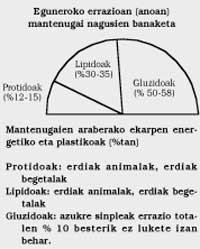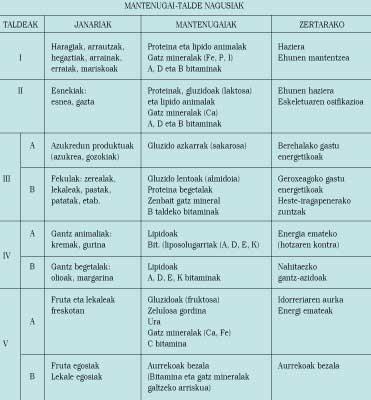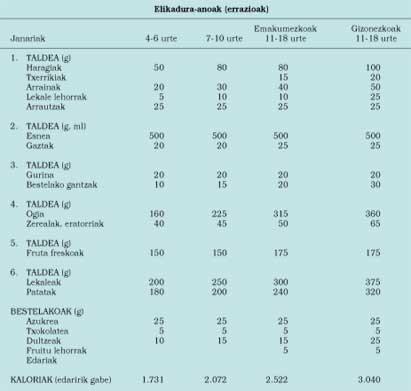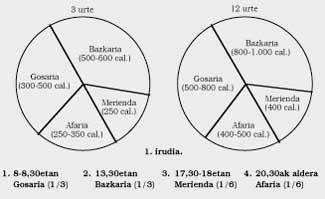Children's food for children
In the case of a child of school age, several stages or phases are differentiated:
- Preschool from 4 to 6 years
- School period from 7 to 12 years
- Adolescence, from 13 to 17-18 years
The chronological age of the child, the rate of aging, the degree of maturity, physical activity and the absorption and use of the foods that are ingested, are some of the factors that should be taken into account when defining and quantifying the maintenance requirements.

In all these stages, the body is in a continuous process of growth, while physical activity is hard and irregular. Baseline metabolic expenditure is higher than that which occurs in adults, and water and heat lost through the skin are also higher in children.
High metabolic expense, rapid biological changes and special hormonal status, which are sufficient reasons to consider these vital stages especially anabolic.
The person, in this case the child, in addition to these inherited or spontaneous factors, can alter the genetic possibilities, increasing or decreasing. Among these environmental factors are eating habits, both proper and social, as well as family and social conditions. All these factors will have a great influence on maintenance.
Numerous international organizations (WHO, FAO, UNICEF, etc.) have marked the amounts of each nutrient needed to reach an optimal level of health per age group. These demands or needs go beyond the physiological demands themselves, since in the same age group changes within normality are allowed.
Needs of calories
The maintenance needs of a young person in full growth process are more linked to their height and physical activity than to their age or weight. On the other hand, we must take into account personal changes in terms of daily needs, family habits and individual capacities or possibilities.
In view of the caloric needs of each age group, the percentage distribution of calories is as follows:
- 50% - 60% for carbohydrates, sugars
- 25% - 35% for fats or fats
- 10% to 15 proteins
Protein needs
In these ages the protein needs are proportionally superior to those of adults due to the special quota that growth imposes on consumption. Proteins should be of high biological value, so it is important that the animal protein present 1/3 - 1/2 (33-50%) of the total contribution. And from 10 years the top would be 50%.
Milk is one of the main sources of protein, so it is a key food to meet these needs. It is recommended to take at least half a liter of milk a day.
Eggs, meat and fish are also an important source of proteins, among which are those of vegetable origin, from cereals, fruits and vegetables.
Fat needs fat
Fats play a specific role in food. In addition to their energy value, some contain essential fatty acids and fat-soluble vitamins.
The greatest contribution of feed fats is usually made through three sources:
- vegetable oils (olive, corn, sunflower, ...)
- animal fats (pork, butter, milk, ...)
- Nuts (hazelnuts, nuts, ...)
Water and liquid needs
The liquid needs are very different in healthy children. The total amounts for 24 hours would be:
- 1,600-1,800 ml for children aged 4 years
- 2.200-2.700 ml for 18 years
Standards for the preparation of the basic measure

Taking into account all the previous needs, when planning a suitable meal measure, certain rules or recommendations are necessary:
- Caloric contribution sufficient to satisfy own needs.
- Maintain an adequate balance and proportion between the different key topics. The key topics should be: 50% carbohydrate, 35% fat and 15% protein.
- The distribution of meals throughout the day should be done in a balanced way. Two basic meals (breakfast and food) and two smaller ones (snack and dinner) can be made.
However, this form, even if it is the most logical and suitable for health, is quite far from our customs. That's why, halfway or, simply, another proposal: three strong enough meals and two other intermediates (lunch and snack), correctly distributing the calories in five shifts.
- To balance well the contribution of proteins between those of animal and vegetable origin.
- A balance should be maintained between animal and vegetable fats, not forgetting that much of the fat is ingested as hidden fat.
- The contribution of sugars should be made especially at the back of starches, using as much as possible products that generate a lot of waste.
- The ration of vitamins and minerals is completed with the introduction of fruits and vegetables in the diet.
- The size of the food should be very varied and that more than 25% of the calories do not come from a single type of food.
- It is also necessary to evaluate the tastes, customs, social and economic conditions, offering whenever it is possible more than one option (so that it is possible to choose one or another food with the same nutritional value).
- The caloric value of beverages will also be calculated.
The fundamental issues are of different composition, and that difference is the main barrier that is found in practice when you want to complete the measure of adequate food. In the table above you can see how the main food groups are formed in their nutrients, what they serve and what main functions they perform in our body.
Except oil, sugar and salt, all conventional foods or foods are made up of more than an immediate principle or essential substance, in addition to water. The conservative values and characteristics of food depend on this different composition.
There are many procedures to facilitate the planning of dietary schemes, such as grouping foods according to the principle of resemblance, or denominating dietary units, etc.
In the following table, based on a conventional classification of food and carrying out an evaluation of the contributions, a scheme of a diet or a measure of food is proposed, by applying rations or rations in grams or milliliters (depending on what is appropriate):
How to distribute the food every day?
Experts in nutrition and maintenance recommend making four meals a day while the person grows and, if possible, respecting the following calorie distribution:
- 25% daily calories in breakfast
- Food 30% daily calories
- 15% daily calories in Snack
- Dinner 30% daily calories
Therefore, 55% of the total calories in the first half of the day.

It is interesting to maintain a certain regularity in terms of the time of the meal and even more how young the body is: this demand should be kept especially in infants; the Begira/Sueño alternation, that is, the turn to be awake/asleep since the food/rest is assimilated directly to the rhythm.
On the other hand, organs and viscera that practice digestion are not able (not prepared) to ingest food continuously. They can only be taken at certain times or, in other words, at least with certain intervals for metabolic transformation to occur properly.
Approximately two-thirds of the caloric ration occurs in the first half of the day, so that the body can cope with the expenses required by the physical and mental activities of the day. The distribution of the last third in two meals (between snack and dinner), for its part, would eliminate the excess weight of the dinner and facilitate the necessary rest between the night, since the digestion would be lighter.
Qualitative distribution of the main food groups
Prosthesis Prosthesis Prosthesis Prosthesis Prosthesis Prosthesis
In a well-balanced diet or diet, prosthesids represent between 12 and 15% of the total daily caloric intake.
Severe hyperprotein diets (with more than 50% of prosthesids) limit appetite and in some cases are used in diets or diet regimens to weaken (in the ATKINS diet, e.g. ).
This 12-15 percent is distributed by ages. For very young children, due to their special requirements in tissue manufacturing, it seems appropriate to recommend a 15% figure and go down slowly to 12% for adults.
The most suitable feeding protein (as for amino acids) is the whole egg. If the biological value of the egg protein is set to 100 per 100, comparatively this coefficient of assimilation is reduced to 80-85 for cow milk and 80-90 for meat.
Animal proteins (mainly those from eggs/dairy) are the best foods for the child, since they are those that have higher metabolic and plastic performance. However, it is highly recommended to increase the consumption of vegetable proteins from early ages, to go against the tendency to excessive consumption of meat in Western societies. On the other hand, proteins of animal origin are very rich in saturated fats or fats, which can cause diseases throughout life (arteriosclerosis, diseases related to cholesterol, etc. ). ).
The vegetarian or medium-sized edible diet (composed of vegetables, dairy and eggs, without meat or fish of any kind) would not ensure adequate growth or exaltation, without giving additives or supplements.
Therefore, we should try to maintain the proper omniscience of the human species, avoiding the consumption of red meat in excess and making a lighter diet and according to current trends.
Foods rich in prosthesis are:
- Of animal origin: meat, red or white (15-20%) eggs (13%) fish (15-20%) cheeses (15-30% according to different types)
- Of vegetable origin: cereals (7-12%) lentils (25%)
- Other: soy (24%-38%). Taste problem Algae (12-75%) Industrial flour (50%)concentrated (60 - 70%)




Note: Note: See the tables in PDF format.
Buletina
Bidali zure helbide elektronikoa eta jaso asteroko buletina zure sarrera-ontzian











